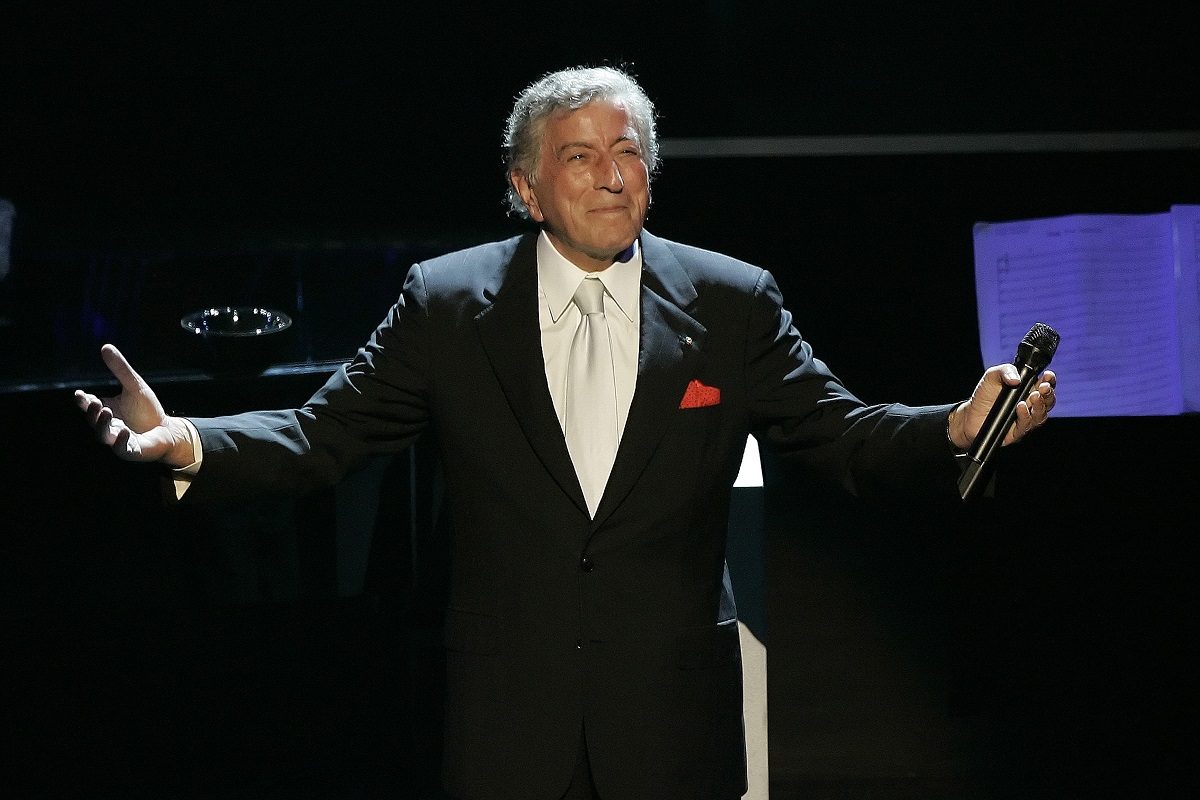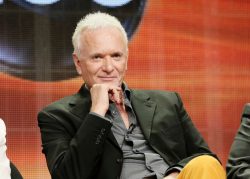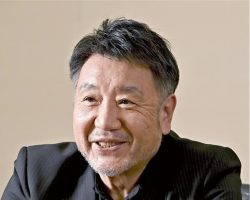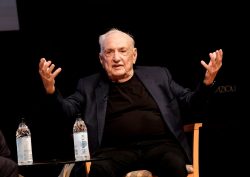
Tony Bennett reacts after performing the song “I left My Heart in San Francisco” during his 80th birthday celebration at the Kodak Theater in Los Angeles, on Nov. 9, 2006.
22:13 JST, July 21, 2023
NEW YORK (AP) — Tony Bennett, the eminent and timeless stylist whose devotion to classic American songs and knack for creating new standards such as “I Left My Heart In San Francisco” graced a decadeslong career that brought him admirers from Frank Sinatra to Lady Gaga, died Friday. He was 96, just two weeks short of his birthday.
Publicist Sylvia Weiner confirmed Bennett’s death to The Associated Press, saying he died in his hometown of New York. There was no specific cause, but Bennett had been diagnosed with Alzheimer’s disease in 2016.
The last of the great saloon singers of the mid-20th century, Bennett often said his lifelong ambition was to create “a hit catalog rather than hit records.” He released more than 70 albums, bringing him 19 competitive Grammys — all but two after he reached his 60s — and enjoyed deep and lasting affection from fans and fellow artists.
Bennett didn’t tell his own story when performing; he let the music speak instead — the Gershwins and Cole Porter, Irving Berlin and Jerome Kern. Unlike his friend and mentor Sinatra, he would interpret a song rather than embody it. If his singing and public life lacked the high drama of Sinatra’s, Bennett appealed with an easy, courtly manner and an uncommonly rich and durable voice — “A tenor who sings like a baritone,” he called himself — that made him a master of caressing a ballad or brightening an up-tempo number.
I enjoy entertaining the audience, making them forget their problems, he told The Associated Press in 2006. “I think people … are touched if they hear something that’s sincere and honest and maybe has a little sense of humor. … I just like to make people feel good when I perform.”
Bennett was praised often by his peers, but never more meaningfully than by what Sinatra said in a 1965 Life magazine interview: “For my money, Tony Bennett is the best singer in the business. He excites me when I watch him. He moves me. He’s the singer who gets across what the composer has in mind, and probably a little more.”
He not only survived the rise of rock music but endured so long and so well that he gained new fans and collaborators, some young enough to be his grandchildren. In 2014, at age 88, Bennett broke his own record as the oldest living performer with a No. 1 album on the Billboard 200 chart for “Cheek to Cheek,” his duets project with Lady Gaga. Three years earlier, he topped the charts with “Duets II,” featuring such contemporary stars as Gaga, Carrie Underwood and Amy Winehouse, in her last studio recording. His rapport with Winehouse was captured in the Oscar-nominated documentary “Amy,” which showed Bennett patiently encouraging the insecure young singer through a performance of “Body and Soul.”
His final album, the 2021 release “Love for Sale,” featured duets with Lady Gaga on the title track, “Night and Day” and other Porter songs.
For Bennett, one of the few performers to move easily between pop and jazz, such collaborations were part of his crusade to expose new audiences to what he called the Great American Songbook.
No country has given the world such great music, Bennett said in a 2015 interview with Downbeat Magazine. “Cole Porter, Irving Berlin, George Gershwin, Jerome Kern. Those songs will never die.”
Ironically, his most famous contribution came through two unknowns, George Cory and Douglass Cross, who in the early ’60s provided Bennett with his signature song at a time his career was in a lull. They gave Bennett’s musical director, pianist Ralph Sharon, some sheet music that he stuck in a dresser drawer and forgot about until he was packing for a tour that included a stop in San Francisco.
Ralph saw some sheet music in his shirt drawer … and on top of the pile was a song called ‘I Left My Heart In San Francisco.’ Ralph thought it would be good material for San Francisco, Bennett said. “We were rehearsing and the bartender in the club in Little Rock, Arkansas, said, ‘If you record that song, I’m going to be the first to buy it.'”
Released in 1962 as the B-side of the single “Once Upon a Time,” the reflective ballad became a grassroots phenomenon staying on the charts for more than two years and earning Bennett his first two Grammys, including record of the year.
By his early 40s, he was seemingly out of fashion. But after turning 60, an age when even the most popular artists often settle for just pleasing their older fans, Bennett and his son and manager, Danny, found creative ways to market the singer to the MTV Generation. He made guest appearances on “Late Night with David Letterman” and became a celebrity guest artist on “The Simpsons.” He wore a black T-shirt and sunglasses as a presenter with the Red Hot Chili Peppers at the 1993 MTV Music Video Awards, and his own video of “Steppin’ Out With My Baby” from his Grammy-winning Fred Astaire tribute album ended up on MTV’s hip “Buzz Bin.”
That led to an offer in 1994 to do an episode of “MTV Unplugged” with special guests Elvis Costello and k.d. lang. The evening’s performance resulted in the album, “Tony Bennett: MTV Unplugged,” which won two Grammys, including album of the year.
Bennett would win Grammys for his tributes to female vocalists (“Here’s to the Ladies”), Billie Holiday (“Tony Bennett on Holiday”), and Duke Ellington (“Bennett Sings Ellington — Hot & Cool”). He also won Grammys for his collaborations with other singers: “Playin’ With My Friends — Bennett Sings the Blues,” and his Louis Armstrong tribute, “A Wonderful World” with lang, the first full album he had ever recorded with another singer. He celebrated his 80th birthday with “Duets: An American Classic,” featuring Barbra Streisand, Paul McCartney and Stevie Wonder among others.
They’re all giants in the industry, and all of a sudden they’re saying to me ‘You’re the master,’ Bennett told the AP in 2006.
Long associated with San Francisco, Bennett would note that his true home was Astoria, the working-class community in the New York City borough of Queens, where he grew up during the Great Depression. The singer chose his old neighborhood as the site for the “Fame”-style public high school, the Frank Sinatra School of the Arts, that he and his third wife, Susan Crow Benedetto, a former teacher, helped found in 2001.
The school is not far from the birthplace of the man who was once Anthony Dominick Benedetto. His father was an Italian immigrant who inspired his love of singing, but he died when Anthony was 10. Bennett credited his mother, Anna, with teaching him a valuable lesson as he watched her working at home, supporting her three children as a seamstress doing piecework after his father died.
We were very impoverished, Bennett said in a 2016 AP interview. “I saw her working and every once in a while she’d take a dress and throw it over her shoulder and she’d say, ‘Don’t have me work on a bad dress. I’ll only work on good dresses.'”
He studied commercial art in high school, but had to drop out to help support his family. The teenager got a job as a copy boy for the AP, performed as a singing waiter and competed in amateur shows. A combat infantryman during World War II, he served as a librarian for the Armed Forces Network after the war and sang with an army big band in occupied Germany. His earliest recording is a 1946 air check from Armed Forces Radio of the blues “St. James Infirmary.”
Bennett took advantage of the GI Bill to attend the American Theater Wing, which later became The Actors Studio. His acting lessons helped him develop his phrasing and learn how to tell a story. He learned the more intimate Bel Canto vocal technique which helped him sustain and extend the expressive range of his voice. And he took to heart the advice of his vocal coach, Miriam Spier.
She said please don’t imitate other singers because you’ll just be one of the chorus whoever you imitate whether it’s Bing Crosby or Frank Sinatra and won’t develop an original sound, Bennett recalled in the 2006 AP interview. “She said imitate musicians that you like, find out how they phrase. I was particularly influenced by the jazz musicians like (pianist) Art Tatum and (saxophonists) Lester Young and Stan Getz.”
In 1947, Bennett made his first recording, the Gershwins’ standard “Fascinatin’ Rhythm” for a small label under the stage name Joe Bari. The following year he gained notice when he finished behind Rosemary Clooney on the radio show “Arthur Godfrey’s Talent Scouts.” Bennett’s big break came in 1949 when singer Pearl Bailey invited him to join her revue at a Greenwich Village club. Bob Hope dropped by one night and was so impressed that he offered the young singer a spot opening his shows at the famed Paramount Theater, where teens had swooned for Sinatra. But the comedian didn’t care for his stage name and thought his real name was too long for the marquee.
He thought for a moment, then he said, ‘We’ll call you Tony Bennett,’ the singer wrote in his autobiography, “The Good Life,” published in 1998.
In 1950, Mitch Miller, the head of Columbia Records’ pop singles division, signed Bennett and released the single, “The Boulevard of Broken Dreams,” a semi-hit. Bennett was on the verge of being dropped from the label in 1951 when he had his first No. 1 on the pop charts with “Because of You.” More hits followed, including “Rags to Riches,” “Blue Velvet,” and Hank Williams’ “Cold, Cold Heart,” the first country song to become an international pop hit.
Bennett found himself frequently clashing with Miller, who pushed him to sing Sinatra-style ballads and gimmicky novelty songs. But Bennett took advantage of the young LP album format, starting in 1955 with “Cloud 7,” featuring a small jazz combo led by guitarist Chuck Wayne. Bennett reached out to the jazz audience with such innovative albums as the 1957 “The Beat of My Heart,” an album of standards that paired him with such jazz percussion masters as Chico Hamilton, and Art Blakey. He also became the first white male singer to record with the Count Basie Orchestra, releasing two albums in 1958. Sinatra would later do the same.
Bennett’s friendship with Black musicians and his disgust at the racial prejudice he encountered in the Army led him to become an active supporter of the Civil Rights Movement. He answered Harry Belafonte’s call to join Martin Luther King Jr.’s 1965 Selma-to-Montgomery voting rights march and perform for the protesters.
Bennett’s early career peaked in the 1960s as he topped the charts with “San Francisco” and became the first male pop solo performer to headline at Carnegie Hall, releasing a live album of the 1962 concert.
In 1966, he released “The Movie Song Album,” a personal favorite which featured Johnny Mandel’s Oscar-winning song “The Shadow of Your Smile” and “Maybe September,” the theme from the epic flop “The Oscar,” noteworthy because it marked Bennett’s first and only big-screen acting role.
But as rock continued to overtake traditional pop, he clashed with Columbia label head Clive Davis, who insisted that the singer do the 1970 album “Tony Sings the Great Hits of Today,” with such songs as “MacArthur Park” and “Little Green Apples.” Bennett left Columbia in 1972, and went on to form his own record label, Improv, which in 1975-76 produced two duet albums with the impressionistic pianist Bill Evans now considered jazz classics.
Despite artistic successes, Improv proved a financial disaster for Bennett, who also faced difficulties in his personal life. His marriage to artist Patricia Beech collapsed in 1971. He wed actress Sandra Grant the same year, but that marriage ended in 1984. With no recording deals, his debts brought him close to bankruptcy and the IRS was trying to seize his house in Los Angeles. After a near-fatal drug overdose in 1979, he turned to his son, Danny, who eventually signed on as his manager. Bennett kicked his drug habit and got his finances in order, moved back to New York and resumed doing more than 200 shows a year.
He is survived by his wife Susan, daughters Johanna and Antonia, sons Danny and Dae and nine grandchildren.
Bennett was named a Kennedy Center Honoree in 2005 and a National Endowment for the Arts Jazz Master in 2006. He also won two Emmy Awards — for “Tony Bennett Live By Request: A Valentine Special” (1996) and “Tony Bennett: An American Classic” (2007).
Besides singing, Bennett pursued his lifelong passion for painting by taking art lessons and bringing his sketchbook on the road. His paintings, signed with his family name Benedetto — including portraits of his musician friends and Central Park landscapes — were displayed in public and private collections, including the Smithsonian Museum of American Art.
I love to paint as much as I love to sing, Bennett told the AP in 2006. “It worked out to be such a blessing in my life because if I started getting burnt-out singing … I would go to my painting and that’s a big lift. … So I stay in this creative zone all the time.”
"Society" POPULAR ARTICLE
-

M4.9 Earthquake Hits Tokyo, Neighboring Prefectures
-

M7.5 Earthquake Hits Northern Japan; Tsunami Waves Observed in Hokkaido, Aomori and Iwate Prefectures
-

Israeli Tourists Refused Accommodation at Hotel in Japan’s Nagano Pref., Prompting Protest by Israeli Embassy and Probe by Prefecture
-

Tsukiji Market Urges Tourists to Avoid Visiting in Year-End
-

M5.7 Earthquake Hits Japan’s Kumamoto Pref., Measuring Upper 5 Intensity, No Tsunami Expected
JN ACCESS RANKING
-

Keidanren Chairman Yoshinobu Tsutsui Visits Kashiwazaki-Kariwa Nuclear Power Plant; Inspects New Emergency Safety System
-

Imports of Rare Earths from China Facing Delays, May Be Caused by Deterioration of Japan-China Relations
-

University of Tokyo Professor Discusses Japanese Economic Security in Interview Ahead of Forum
-

Japan Pulls out of Vietnam Nuclear Project, Complicating Hanoi’s Power Plans
-

Govt Aims to Expand NISA Program Lineup, Abolish Age Restriction




















